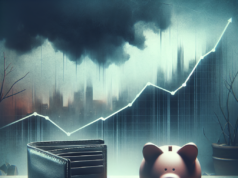In 2023, the corporate landscape has witnessed a significant surge in bankruptcy filings, raising alarms among economists, investors, and policymakers alike. This trend, marked by a notable increase in the number of companies seeking legal protection from creditors, reflects a confluence of economic pressures and sector-specific challenges. As businesses grapple with mounting debts, changing consumer behaviors, and a volatile market environment, understanding the intricacies of this crisis becomes crucial for stakeholders across the board.
Understanding the Surge: An Overview of Recent Corporate Bankruptcy Filings
The recent spike in corporate bankruptcy filings has been striking, with reports indicating a nearly 30% increase compared to the previous year. Notable cases have emerged across various sectors, including retail, technology, and manufacturing, highlighting the widespread nature of this crisis. According to data from the American Bankruptcy Institute, over 5,000 companies filed for Chapter 11 protection in the first half of 2023 alone, signaling a troubling trend that has prompted urgent discussions about the sustainability of business models in an increasingly challenging economic environment. This surge not only reflects the immediate financial distress faced by these companies but also raises questions about the long-term viability of numerous industries.
Key Factors Driving the Increase in Corporate Bankruptcy Cases in 2023
Several key factors have contributed to the rise in corporate bankruptcies this year. First and foremost, inflation has continued to exert pressure on operational costs, with rising prices for raw materials, labor, and logistics significantly impacting profit margins. Additionally, the lingering effects of the COVID-19 pandemic have reshaped consumer behavior, leading to shifts in demand that many companies have struggled to adapt to. Interest rates have also risen sharply, making it more expensive for businesses to service existing debts or secure new financing. Coupled with geopolitical uncertainties and supply chain disruptions, these elements have created a perfect storm, pushing many corporations to the brink of insolvency.
The Economic Impact: How Rising Bankruptcies Affect the Broader Market Landscape
The surge in corporate bankruptcies has far-reaching implications for the broader economy. As companies close their doors or undergo restructuring, job losses are inevitable, contributing to rising unemployment rates and reduced consumer spending. This, in turn, can lead to a slowdown in economic growth, as fewer jobs mean less disposable income circulating in the economy. Moreover, the financial distress of these companies can have a cascading effect on suppliers, creditors, and even competitors, creating a ripple effect that exacerbates market instability. Investors are also feeling the impact, as increased bankruptcies can lead to heightened volatility in stock prices and a reevaluation of risk across various sectors.
Sector-Specific Analysis: Industries Most Affected by the Bankruptcy Wave
While the bankruptcy crisis spans multiple sectors, certain industries have been disproportionately affected. The retail sector, for instance, has seen a wave of high-profile bankruptcies, as traditional brick-and-mortar stores struggle to compete with e-commerce giants and changing consumer preferences. Similarly, the energy sector has faced significant challenges, particularly in fossil fuel industries, as the global push for renewable energy sources accelerates. The technology sector, once a beacon of growth, is also experiencing turmoil, with several startups and established firms alike facing financial headwinds due to rising operational costs and a tightening venture capital landscape. This sector-specific analysis underscores the need for tailored strategies to address the unique challenges faced by different industries.
Legal Considerations: Navigating the Bankruptcy Process for Corporations
For corporations facing financial distress, navigating the bankruptcy process can be a complex and daunting task. Understanding the legal framework surrounding bankruptcy is essential for companies seeking to protect their assets and restructure their debts. Chapter 11 bankruptcy, which allows businesses to reorganize while continuing operations, has become a common route for many firms. However, the process involves intricate legal considerations, including negotiations with creditors, potential asset sales, and compliance with court requirements. Companies must also weigh the implications of bankruptcy on their brand reputation and stakeholder relationships. Engaging experienced legal counsel is crucial to effectively navigate these challenges and develop a viable path forward.
Future Outlook: Predictions and Strategies for Businesses Facing Financial Distress
Looking ahead, the outlook for businesses facing financial distress remains uncertain. Experts predict that the trend of rising bankruptcies may continue into 2024, particularly if economic conditions do not improve. However, companies can adopt proactive strategies to mitigate risks and enhance resilience. This includes conducting thorough financial assessments, exploring alternative financing options, and diversifying revenue streams to reduce dependency on any single market segment. Additionally, investing in technology and innovation can help businesses adapt to changing consumer preferences and improve operational efficiency. Ultimately, a strategic approach that emphasizes flexibility and adaptability will be essential for companies seeking to navigate the ongoing challenges of a turbulent economic landscape.
The surge in corporate bankruptcy filings in 2023 serves as a stark reminder of the vulnerabilities inherent in the business landscape. As companies confront a myriad of challenges, from inflation to shifting consumer behaviors, the need for strategic foresight and robust financial management has never been more critical. Stakeholders must remain vigilant and responsive to the evolving economic climate, as the implications of this crisis extend far beyond individual companies, affecting the broader market and economy. By understanding the factors driving this trend and implementing effective strategies, businesses can better position themselves to weather the storm and emerge stronger in the face of adversity.






















